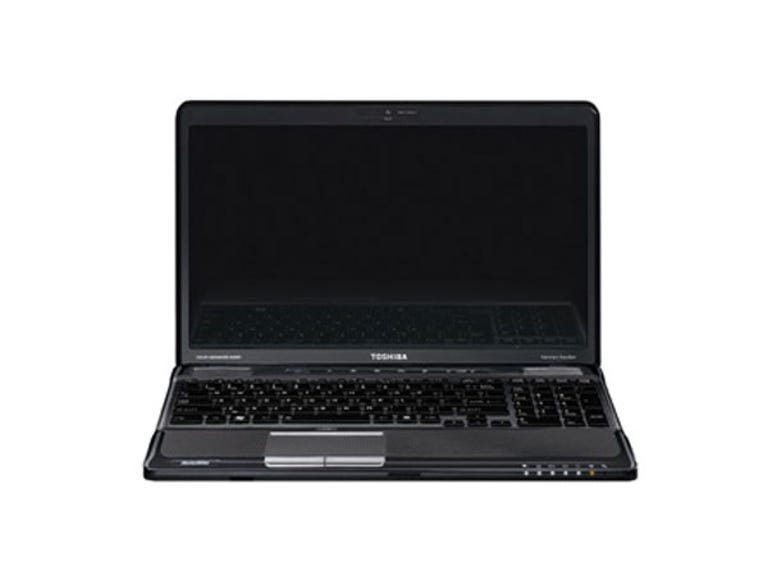 Why You Can Trust CNET
Why You Can Trust CNET Toshiba Satellite A660/07R review: Toshiba Satellite A660/07R
Toshiba's 3D-capable laptop works exceptionally well as a desktop replacement, especially for gamers.
The Good
The Bad
The Bottom Line
Design
Toshiba promotes the Satellite A660 — or more specifically, the A660/07R PSAW3A-07R00R, as there are many models of A660 — as the "ultimate all-round high performance entertainment machine, featuring true 3D for a totally immersive gaming and movie viewing experience". It's silly in the extreme to call any product "ultimate" — where do you go to from there, exactly? — but still the design of the A660 leaves little doubt that this is a high-gloss, "in your face"-style entertainment notebook.
The large backlit keyboard includes a number pad and a row of touch-sensitive buttons, although curiously the space bar is comparatively tetchy. The finish is undeniably plastic but exceptionally shiny, and one of those matters of personal taste. Some will love its in-your-face aesthetic; we found it a little tiring after a while.
The other accessory that leaps out of the box at you is a pair of Nvidia's 3D glasses along with a USB transmitter in a big green shiny box. You only get a single pair, but then the 3D chops of this system are much more focused around 3D gaming than social 3D movie watching in any case.
Features
The A660 we tested was kitted out with a little bit of everything, and then a few bits more. Specifically, it runs on an Intel Core i7 processor 740QM 1.73GHz processor, 4GB of DDR3 RAM, 640GB (5400rpm) SATA hard drive and Nvidia GeForce GTS350M 1GB graphics chip. The optical drive is a Blu-ray RW/DVD SuperMulti double/dual-layer drive, with further entertainment options handled by an in-built Hybrid Digital/Analog TV Tuner. Four USB ports are present, with one being a shared eSATA/USB port that's also powered up even when the laptop is off for the purposes of charging other USB gadgetry. Other ports include VGA, HDMI, PCI Express, SD and gigabit Ethernet. Bluetooth 2.1 and 802.11n Wi-Fi is supported.
On the software side, the default operating system install is Windows 7 Home Premium 32-bit, but on first boot you're given the option to use a recovery partition for Windows 7 Home Premium 64-bit. Trial versions of Microsoft Office 2007 (60 days) and Norton Internet Security are also pre-installed.
Performance
As could be expected from a system with specifications like these, our standard benchmarks were something of a pushover for the A660. It scored a healthy 8393 in 3DMark06 and 6995 in PCMark05. While it's clearly an entertainment PC at heart, there's not too many tasks you could throw at the A660 that it couldn't handle.
We did discover at least one thing it wasn't too happy with, however. It may have just been our review sample, but the hard drive parking sensor on the A660 is exceptionally sensitive to movement. On a desk or flat surface this isn't an issue, but if you do use it on a lap, be prepared for lots of little pauses in your entertainment flow when the hard drive detects motion. A system of this size isn't entirely a lap-bound creature, but it'd be nice to be able to use it off a desk from time to time.
Clearly a big pitch point for this particular laptop is 3D gaming, and the embedded Nvidia solutions works quite well. We tested with Just Cause 2, and aside from a little bit of shimmer, which was adjusted for via the scroll wheel on the USB-connect 3D transmitter, the 3D effect worked exceptionally well. Naturally, as with any 3D source, anyone wandering by while you're busy blowing up red barrels will be near blinded by the discordant images on-screen.
Large laptops with plenty of multimedia grunt aren't usually the poster children for exceptional battery life, but we were stunned at exactly how poor the A660's battery performance was. Our standard battery test disables all power-saving measures and sets screen brightness to maximum before playing an XviD file at full-screen resolution looped to the point of hibernation in order to get a worst-case scenario figure for battery performance. Typically for a larger screened notebook we'd expect to see something in the region of 90 to 120 minutes.
The A660's battery died out in 67 minutes, a new low watermark for battery performance. Given the issues we had with its hard drive parking sensor we're not sure how much you'd want to lug it around for portable work in any case, but the poor battery life makes this entire argument something of a non-starter.
Conclusion
The A660 is a high-end gamer's laptop, priced accordingly and with very few pretensions to mobile work, especially given its 2.62kg carrying weight and sub-par battery life. If you can live with those restrictions and want an all-in-one home entertainment desktop replacement notebook, it's a good buy.


